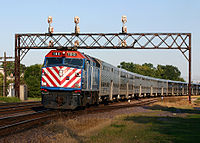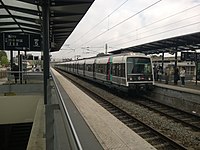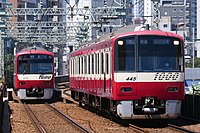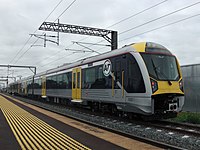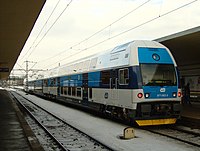Commuter rail
This article possibly contains original research. (April 2024) |
This article needs additional citations for verification. (August 2019) |
- A F40PH in Chicago
- A renovated MI 79 of the Réseau Express Régional in Paris
- A CPTM train on the Coral Line in São Paulo
- A CityElefant train in Prague
- An AM class electric multiple unit used in Auckland
- Two N1000 series EMUs of the Keikyu railway pass each other in Tokyo
Commuter rail, or suburban rail, is a
The term can refer to systems with a wide variety of different features and service frequencies, but is often used in contrast to rapid transit or light rail.
Some services share similarities with both commuter rail and high-frequency rapid transit; examples being the German S-Bahn in some cities, the Réseau Express Régional (RER) in Paris, the S Lines in Milan, many Japanese commuter systems, the East Rail line in Hong Kong and some Australasian suburban networks, such as Sydney Trains. Some services, like British commuter rail, share tracks with other passenger services and freight.
In North America, commuter rail sometimes refers only to systems that primarily operate during peak periods and offer little to no service for the rest of the day, with regional rail being used to refer to systems that offer all-day service.[4][5][6]
Characteristics
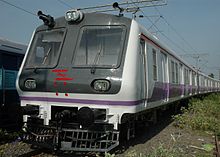
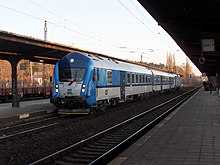
Most commuter (or suburban) trains are built to main line rail standards,[7] differing from light rail or rapid transit (metro rail) systems by:
- being larger
- providing more seating and less standing room, owing to the longer distances involved
- having (in most cases) a lower frequency of service
- having scheduled services (i.e. trains run at specific times rather than at specific intervals)
- serving lower-density suburban areas, typically connecting suburbs to the city center
- sharing track or freighttrains
- not fully grade separated (containing at-grade crossings with crossing gates)
- being able to skip certain stations as an express service due to normally being driver controlled
Train schedule
Compared to
The general range of commuter trains' travel distance varies between 15 and 200 km (10 and 125 miles), but longer distances can be covered when the trains run between two or several cities (e.g. S-Bahn in the Ruhr area of Germany). Distances between stations may vary, but are usually much longer than those of urban rail systems. In city centres the train either has a terminal station or passes through the city centre with notably fewer station stops than those of urban rail systems. Toilets are often available on-board trains and in stations.
Track
Their ability to coexist with freight or intercity services in the same
Most such trains run on the
Distinction between other modes of rail
| Part of a series on |
| Rail transport |
|---|
 |
|
|
| Infrastructure |
|
|
| Service and rolling stock |
|
| Special systems |
|
|
| Miscellanea |
|
|
Metro
Metro rail and rapid transit usually cover smaller inner-urban areas within 12 to 20 km (7 to 12 mi) of city centers, with shorter stop spacing, use rolling stocks with larger standing spaces, lower top speed and higher acceleration, designed for short-distance travel. They also run more frequently, to a headway rather than a published timetable and use dedicated tracks (underground or elevated), whereas commuter rail often shares tracks, technology and the legal framework within mainline railway systems, and uses rolling stocks with more seating and higher speed for comfort on longer city-suburban journeys. [citation needed]
However, the classification as a metro or rapid rail can be difficult as both may typically cover a metropolitan area exclusively, run on separate tracks in the centre, and often feature purpose-built rolling stock. The fact that the terminology is not standardised across countries (even across English-speaking countries) further complicates matters. This distinction is most easily made when there are two (or more) systems such as New York's subway and the LIRR and Metro-North Railroad, Paris' Métro and RER along with Transilien, Washington D.C.'s Metro along with its MARC and VRE, London's tube lines of the Underground and the Overground, Elizabeth line, Thameslink along with other commuter rail operators, Madrid's Metro and Cercanías, Barcelona's Metro and Rodalies, and Tokyo's subway and the JR lines along with various privately owned and operated commuter rail systems.
Regional rail
Inter-city rail
In some European countries, the distinction between commuter trains and long-distance/intercity trains is subtle, due to the relatively short distances involved. For example, so-called "intercity" trains in Belgium and the Netherlands carry many commuters, while their equipment, range, and speeds are similar to those of commuter trains in some larger countries.
The United Kingdom has a privatised rail system, with different routes and services covered by different private operators. The distinction between commuter and intercity rail is not as clear as it was before privatisation (when InterCity existed as a brand of its own), but usually it is still possible to tell them apart. Some operators, for example Thameslink, focus solely on commuter services. Others, such as Avanti West Coast and LNER, run solely intercity services. Others still, such as GWR and EMR, run a mixture of commuter, regional and intercity services. Some of these operators use different branding for different types of service (for example EMR brands its trains as either "InterCity", "Connect" for London commuter services, and "Regional") but even for those operators that do not, the type of train, amenities offered, and stopping pattern, usually tell the services apart.
Russian commuter trains, on the other hand, frequently cover areas larger than Belgium itself, although these are still short distances by Russian standards. They have a different ticketing system from long-distance trains, and in major cities they often operate from a separate section of the train station.
Some consider "inter-city" service to be that which operates as an express service between two main city stations, bypassing intermediate stations. However, this term is used in Australia (Sydney for example) to describe the regional trains operating beyond the boundaries of the suburban services, even though some of these "inter-city" services stop all stations similar to German regional services. In this regard, the German service delineations and naming conventions are clearer and better used for academic purposes.
High-speed rail

Sometimes
In South Korea, some sections of the high-speed rail network are also heavily used by commuters, such as the section between
The high-speed services linking Zürich, Bern and Basel in Switzerland (200 km/h (120 mph)) have brought the Central Business Districts (CBDs) of these three cities within 1 hour of each other. This has resulted in unexpectedly high demand for new commuter trips between the three cities and a corresponding increase in suburban rail passengers accessing the high-speed services at the main city-centre stations (Hauptbahnhof). The Regional-Express commuter service between Munich and Nuremberg in Germany runs at 200 km/h (120 mph) on the 300 km/h (186 mph) Nuremberg–Ingolstadt high-speed railway.
The regional trains Stockholm–Uppsala, Stockholm–Västerås, Stockholm–Eskilstuna and Gothenburg–Trollhättan in Sweden reach 200 km/h (120 mph) and have many daily commuters.
In
The
Eskişehir-Ankara and Konya-Ankara high speed train routes serve as high speed commuter trains in Turkey.
Train types
Commuter/suburban trains are usually optimized for maximum passenger volume, in most cases without sacrificing too much comfort and
Multiple unit type
Commuter rail trains are usually composed of
Locomotive hauled services
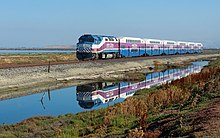
Locomotive hauled services are used in some countries or locations. This is often a case of
Seat plans
In the US and some other countries, a three-and-two seat plan is used. Middle seats on these trains are often less popular because passengers feel crowded and uncomfortable.[14][15]
In Japan, South Korea and Indonesia, longitudinal (sideways window-lining) seating is widely used in many commuter rail trains to increase capacity in rush hours. Carriages are usually not organized to increase
Commuter rail systems around the world
This section needs expansion. You can help by adding to it. (March 2009) |
Africa

Currently there are not many examples of commuter rail in Africa. Metrorail operates in the major cities of South Africa, and there are some commuter rail services in Algeria, Botswana, Kenya, Morocco, Egypt and Tunisia. In Algeria,
Asia
East Asia
In Japan, commuter rail systems have extensive network and frequent service and are heavily used. In many cases, Japanese commuter rail is operationally more like a typical metro system (frequent trains, an emphasis on standing passengers, short station spacings) than it is like commuter rail in other countries. Japanese commuter rail commonly interline with city center subway lines, with commuter rail trains continuing into the subway network, and then out onto different commuter rail systems on the other side of the city. Many Japanese commuter systems operate various stopping patterns to reduce the travel time to distant locations, often using station passing loops instead of dedicated express tracks. It is notable that the larger Japanese commuter rail systems are owned and operated by for-profit private railway companies, without public subsidy.
Other commuter rail routes in Japan include:
- Hanshin Namba Line and Kintetsu Namba Line have a busy east west underground section that allow trains from both Hanshin Electric Railway and Kintetsu Railway to access Namba, a major commercial center of Osaka, and service destinations east and west of Osaka.
- Osaka Metro Sakaisuji Line is a north south line that allows Hankyu services from the Senri Line, Kyoto Main Line and Arashiyama Line to enter Osaka city center.
- Gakkentoshi Line to access Umedain central Osaka.
- JR West Osaka Loop Line is a mostly elevated loop line that allows for services from the Yamatoji Line, Hanwa Line and Sakurajima Line to loop around central Osaka.
- JR West .
- A special private railway Kōbe Rapid Transit Railway owns two underground corridors (a north south and east west line) that allow for Sanyo Electric Railway, Hankyu railway, Hanshin Electric Railway and Kobe Electric Railway services to enter and cross Kobe city center.
- Most of the trains on the Meitetsu network through operate into a high frequency trunk line on the Meitetsu Nagoya Main Line branching out to other lines on the other side of Nagoya.
Commuter rail systems have been inaugurated in several cities in China such as
The two MTR lines which are owned and formerly operated by the Kowloon-Canton Railway Corporation (East Rail line and Tuen Ma line which is integrated from the former West Rail line and Ma On Shan line in 2021), then the "KCR"), and MTR's own Tung Chung line connect the new towns in New Territories and the city centre Kowloon together with frequent intervals, and some New Territories-bound trains terminate at intermediate stations, providing more frequent services in Kowloon and the towns closer to Kowloon. They use rolling stocks with a faster maximum speed and have longer stop spacing compard to other lines which only run in the inner urban area, but in order to maximise capacity and throughput, these rolling stocks have longitudinal seatings, 5 pairs of doors in each carriage with large standing spaces like the urban lines, and run as frequent as well. Most of the sections of these four lines are overground and some sections of the East Rail Line share tracks with intercity trains to mainland China. The three KCR lines are integrated into the MTR network since 2008 and most passengers do not need to exit and re-enter the system through separate fare gates and purchase separate tickets to transfer between such lines and the rest of the network (the exceptions are between the Tuen Ma line's East Tsim Sha Tsui station and the Tsuen Wan line's Tsim Sha Tsui station.
In Taiwan, the
In South Korea, the
Southeast Asia
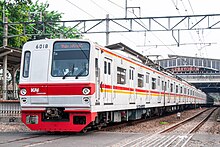
In
In the Philippines, the
In Malaysia, there are two commuter services operated by Keretapi Tanah Melayu. They are the KTM Komuter that serves Kuala Lumpur and the surrounding Klang Valley area, and the KTM Komuter Northern Sector that serves Greater Penang, Perak, Kedah and Perlis in the northern region of Peninsular Malaysia.
In Thailand, the
Another commuter rail system in Southeast Asia is the Yangon Circular Railway in Myanmar.
South Asia
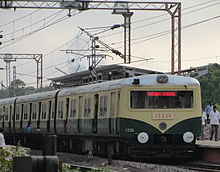
In India, commuter rail systems are present in major cities and form an important part of people's daily lives.
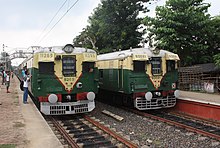
In 2020, Government of India approved
In Bangladesh, there is one suburban rail called the Chittagong Circular Railway. Another suburban railway called the Dhaka Circular Railway is currently proposed.
Karachi in Pakistan has a circular railway since 1969.
West Asia
In Iran, SYSTRA proposed 4 express lines similar to
In Turkey; Başkentray, İZBAN, Marmaray and Gaziray are well-known examples.
Europe
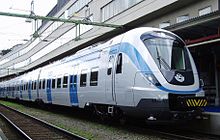
Major metropolitan areas in most European countries are usually served by extensive commuter/suburban rail systems. Well-known examples include
(Ireland).Western Europe
London has multiple commuter rail routes:
- The Elizabeth line runs on a 22-kilometre (14-mile) (14 mi)-long east–west twin tunnel under central London (Crossrail project) as its central core section.
- Thameslink brings together several branches from northern and southern suburbs and satellite towns in to a high frequency central tunnel underneath London.
- The North London Linerun at metro-like frequencies in inner London, which make them nearly indistinguishable from metro systems apart from the fact that the tracks are shared with freight trains.
- The Metropolitan line, despite being part of the London Underground, is a commuter rail route as it links the City of London to commuter towns outside Greater London such as Rickmansworth, Amersham and Chesham, where it runs to a timetable, being the only London Underground line with a public timetable published. It also shares tracks with Chiltern Railways main line services between London and Aylesbury.
The
Birmingham has four suburban routes, one of which is operated with diesel trains.
The
Many of the rail services around Glasgow are branded as Strathclyde Partnership for Transport. The network includes most electrified Scottish rail routes.
The
MetroWest is a proposed network in Bristol, northern Somerset & southern Gloucestershire. The four-tracking of the line between Bristol Temple Meads and Bristol Parkway stations will enable local rail services to be separated from long-distance trains.
The Réseau express régional d'Île-de-France (RER) is a commuter rail network in the agglomeration of Paris. In the centre the RER has high frequency underground corridors where several suburban branches feed similar to a rapid transit system.
Commuter rail systems in Germany are called S-Bahn. While in some major cities S-Bahn services run on separate lines exclusively other systems use the existing regional rail tracks.
In Italy fifteen cities have commuter rail systems:
- Bari (Bari metropolitan railway service, 3 lines)
- Bologna (Bologna metropolitan railway service, 8 lines)
- Cagliari, 1 line
- Catanzaro, 2 lines
- Genoa (Genoa urban railway service, 3 lines)
- Messina, 1 line
- Milan suburban railway service, 12 lines)
- Naples, 8 lines
- Palermo (Palermo metropolitan railway service, 2 lines)
- Perugia, 1 line
- Potenza, 1 line
- Reggio Calabria, 1 line
- Rome (FL lines, 8 lines)
- Salerno (Salerno metropolitan railway service, 1 line)
- Turin metropolitan railway service, 8 lines)
Randstadspoor is a network of Sprinter train services in and around the city of Utrecht in the Netherlands. For the realisation of this network, new stations were opened. Separate tracks have been built for these trains, so they can call frequently without disturbing high-frequent Intercity services parallel to these routes.[17] Similar systems are planned for The Hague and Rotterdam.
Northern Europe
In Sweden, electrified commuter rail systems known as Pendeltåg are present in the cities of Stockholm and Gothenburg. The Stockholm commuter rail system, which began in 1968, shares railway tracks with inter-city trains and freight trains, but for the most part runs on its own dedicated tracks. It is primarily used to transport passengers from nearby towns and other suburban areas into the city centre, not for transportation inside the city centre. The Gothenburg commuter rail system, which began in 1960, is similar to the Stockholm system, but does fully share tracks with long-distance trains.
In Norway, the
In
Southern Europe
In Spain, Cercanías networks exist in Madrid, Sevilla, Murcia/Alicante, San Sebastián, Cádiz, Valencia, Asturias, Santander, Zaragoza, Bilbao and Málaga. All these systems include underground sections in the city centre. There is also a network of narrow-gauge commuter systems in North Spain and Murcia.

Cercanías Madrid is one of the most important train services in the country, more than 900,000 passengers move in the system. It has underground stations in Madrid like Recoletos, Sol or Nuevos Ministerios and in the metropolitan area in cities like Parla or Getafe.
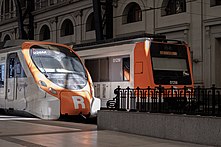
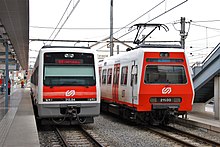
In the
- Renfe (train operator and its maintenance), and Adif (owner of the railway infrastructure).[23] Lines R1, R2, R2 Nord, R2 Sud, R3 (to Sant Quirze de Besora, from there to Puigcerdà or La Tor de Querol it is considered a regional route), R4, R7 and R8 run through Rodalies de Catalunya, all on Iberian gauge(1668 mm).
- Ferrocarrils de la Generalitat de Catalunya (or FGC) is the railway company responsible for the Vallès, Llobregat-Anoia and Lleida-La Pobla de Segur lines.[24] This company is mainly in charge of metro and suburban lines, although it also has five commuter lines spread over two lines, four on the Llobregat-Anoia line (R5, R50, R6, R60) on metre-gauge (1000 mm)[25] and a single line on the Lleida-La Pobla de Segur line (RL1) on Iberian gauge (1668 mm).[26] FGC is in charge of the entire service, unlike Rodalies de Catalunya, which is not in charge of either the trains or the infrastructure.
The
In Italy there are several commuter rail networks:
- Roman FL lines cover most of the Latium regional railways.
- Milan Passante railway.[28]
- Turin metropolitan railway service, operated by Trenitalia and GTT, with an underground railway line running through the city used by most services.[29]
- Naples Metro Line 2 is an underground corridor where commuter rail services operated by Trenitaliatraverse and service the urban center.
- Genoa urban railway service consists in three lines passing through the Giovi railway line and the Tyrrhenian railway lines Genoa–Ventimiglia and Genoa–Pisa.
- Bologna metropolitan railway service. The system comprises 8 lines.[30]
- Bari metropolitan railway service
- Malpensa Airport.
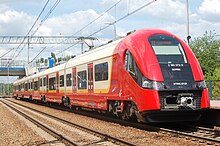
Eastern Europe
In Poland, commuter rail systems exist in Tricity, Warsaw, Kraków (SKA) and Katowice (SKR). There is also a similar system planned in Wrocław and Szczecin.[31] The terms used are "Szybka Kolej Miejska" (fast urban rail) and "kolej aglomeracyjna" (agglomeration rail). These systems are:
- Szybka Kolej Miejska w Warszawie in the Warsaw urban area, with 4 lines and 46 stations.[32][circular reference]
- Łódzka Kolej Aglomeracyjna is located in the center of Poland connecting satellite towns in and around Łódź. It also operates some trains between Łódź and Warsaw.
- Szybka Kolej Miejska w Trójmieście is located in the Tricity/Trójmiasto urban area, the three cities of Gdańsk, Gdynia and Sopot.
The
In Romania, the first commuter trains were introduced in December 2019. They operate between Bucharest and Funduea or Buftea.
In Russia, Ukraine and some other countries of the former Soviet Union, electrical multiple unit passenger suburban trains called Elektrichka are widespread. The first such system in Russia is the Oranienbaum Electric Line in St. Petersburg. In Moscow the Beskudnikovskaya railway branch existed between the 1940s and 1980s. The trains that shuttled along it did not go to the main lines, so it was a city transport. Today there are the Moscow Central Circle and the Moscow Central Diameters.
In Turkey,
Americas
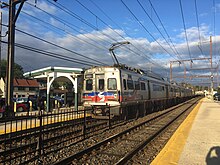
North America
In the United States, Canada, Costa Rica, El Salvador and Mexico regional passenger rail services are provided by governmental or quasi-governmental agencies, with the busiest and most expansive rail networks located in the Northeastern US, California, and Eastern Canada. Most North American commuter railways utilize diesel locomotive propulsion, with the exception of services in New York City, Philadelphia, Chicago, Denver, and Mexico City; New York's commuter rail lines use a combination of third rail and overhead wire power generation, while Chicago only has two out of twelve services that are electrified. Many newer and proposed systems in Canada and the United States are often are geared to serving peak-hour commutes as opposed to the all-day systems of Europe, East Asia, and Australia.
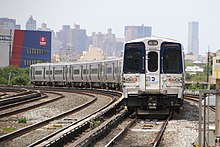
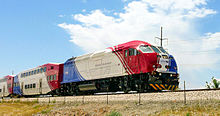
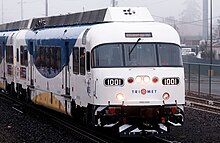
United States
Eight commuter rail systems in the United States carried over ten million trips in 2018, those being in descending order:
- Metropolitan Transportation Authority's Long Island Rail Road, serving New York City and Long Island
- NJ Transit Rail Operations, serving New York City, New Jersey (Newark, Trenton) and Philadelphia
- Metropolitan Transportation Authority's Yonkers and New York City) and Southwest Connecticut (New Haven)
- Metra, serving northeast Illinois (Chicago) and Kenosha, Wisconsin. The network consists of 11 services, of which only the Electric District service runs on tracks exclusively used for passenger traffic.
- The South Shore Line is a commuter line that serves the South Side and northern Indiana. Although the line is operated by NICTD, an agency separate from Metra, the line runs along the Metra Electric Line north of Kensington/115th Street station.
- MBTA Commuter Rail, serving Massachusetts (Boston, Worcester, Lowell) and Providence, Rhode Island
- Caltrain, serving California (San Francisco, San Jose, and the San Francisco Peninsula)
- San Bernardino, and Southern California)
Other commuter rail systems in the United States (not in ridership order) are:
- New Haven and New London)
- Utah Transit Authority FrontRunner, serving Utah (Wasatch Front)
- San Diego County)
- Regional Transportation District, serving Colorado (Denver)
- Virginia Railway Express, serving suburbs of Northern Virginia and Washington, D.C.
- Sounder commuter rail, serving Washington (Seattle / Tacoma)
- West Palm Beach)
- Fort Worth)
- Westside Express Service, serving Oregon (Beaverton / Wilsonville)
- Altamont Corridor Express, serving California (San Jose / Stockton)
- Orlando/Poinciana)
- Albuquerque)
- Northstar Line, serving Minnesota (Big Lake and downtown Minneapolis)
- )
- Denton County)
- Marincounties)
- Nashville and Lebanon, Tennessee.
- RTD four electrified commuter rail lines – the A, B, G and N Lines, run on segregated tracks. In its entirety the system combines elements of tram-trainand commuter rail.
Canada
- Exo in Montreal
- GO Transit in Toronto
- West Coast Express in Vancouver
- UP Expressin Toronto
Mexico
- Suburban Railway of the Valley of Mexico Metropolitan Area serving Mexico City
- Toluca–Mexico City commuter rail serving Toluca and Mexico City
Central America
- City Rail serving La Ceiba
- San Salvador Suburban Rail serving San Salvador and Santa Ana
- Rail Transport in Costa Rica serving San Jose
South America
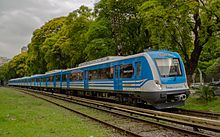
Examples include an 899 km (559 mi) commuter system in the
Another example is Companhia Paulista de Trens Metropolitanos (CPTM) in Greater São Paulo, Brazil. CPTM has 94 stations with seven lines, numbered starting on 7 (the lines 1 to 6 and the line 15 belong to the São Paulo Metro), with a total length of 273 kilometres (170 mi). Trains operates at high frequencies on tracks used exclusively for commuter traffic. In Rio de Janeiro SuperVia provides electrified commuter rail services.
Oceania
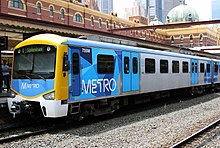
The five major cities in Australia have suburban railway systems in their metropolitan areas. These networks have frequent services, with frequencies varying from every 10 to every 30 minutes on most suburban lines, and up to 3–5 minutes in peak on bundled underground lines in the city centres of Sydney, Brisbane, Perth and Melbourne. The networks in each state developed from mainline railways and have never been completely operationally separate from long distance and freight traffic, unlike metro systems. The suburban networks are almost completely electrified.
The main suburban rail networks in Australia are:
- The Sydney Trains suburban rail network consists of nine lines converging in the underground City Circle with frequencies as high as three minutes in this section, 5–10 minutes at most major stations all day and 15 minutes at most minor stations all day.
- The Sydney rail network operated by Sydney Trains in Sydney (with connected suburban services in Newcastle and Wollongong run by its counterpart intercity operator, NSW TrainLink).
- Melbourne's rail network features sixteen electrified commuter rail lines traversing the city centre in the underground City Loop providing a metro-like service in the central core. A second underground core is under construction, as the Metro Tunnel project. V/Line operates some commuter services between Melbourne and surrounding towns, as well as between Melbourne and some locations within the Melbourne metropolitan area.
- Commuter rail services in Queensland Rail City network brand, featuring twelve electrified lines converging in the city centre. Cross River Railis an under construction underground cross-city tunnel to relieve pressure on this network.
- Railways in Perth fall under the Transperth network, which are operated by the Public Transport Authority
- The Adelaide rail network operated by Adelaide Metro in Adelaide.
New Zealand has two frequent suburban rail services comparable to those in Australia: the Auckland rail network is operated by Auckland One Rail and the Wellington rail network is operated by Transdev Wellington.
Hybrid urban-suburban rail systems
This section possibly contains original research. Where are the sources that confirm this is an actual type of transit system? Where are the references that confirm each example is actually what is stated here? (June 2023) |
Hybrid
See also
- List of suburban and commuter rail systems
- Public transport
- Commuting
- Cercanías, the commuter rail systems of Spain's major metropolitan areas
- Commuter rail in the United Kingdom
- Commuter rail in North America
- Commuter rail in Australia
- S-Bahn, the combined city center and suburban railway system metro in Austria, Germany, Switzerland and Denmark
References
- ^ Transportation Research Board (1989). "Urban Public Transportation Glossary" (PDF). Archived (PDF) from the original on 2019-10-12.
- ^ a b American Public Transit Association (1994). "Glossary of Transit Terminology" (PDF). Archived (PDF) from the original on 2019-10-12.
- ^ "National Transit Database Glossary". 2013-11-13. Archived from the original on 2013-11-13. Retrieved 2019-10-12.
- ^ "What American Commuter Rail Can Learn From Paris". Streetsblog USA. 2017-02-13. Retrieved 2019-10-12.
- ^ Blumgart, Jake (23 April 2021). "Taking the 'Commuter' Out of America's Rail Systems". Governing. e.Republic LLC. Retrieved 11 April 2023.
- ISBN 9781642832136.
- ^ "Commuter Rail |". Retrieved 2020-06-06.
- ^ "National Transit Database (NTD) Glossary". Federal Transit Administration. Retrieved 12 August 2022.
- ^ "Transport Express Régional (TER) – SNCF | train types | railcc". rail.cc. Retrieved 2021-04-27.
- ^ "KORAIL". info.korail.com. Retrieved 2021-04-27.
- ^ "Fact Sheet: High Speed Rail Development Worldwide | White Papers | EESI". www.eesi.org. Retrieved 2019-12-04.
- ^ "JR East to Retire the Last Double-Decker Shinkansen Train – Japan Station". www.japanstation.com. Retrieved 2021-08-11.
- ^ "Metro closes the gap with areas across the border – SHINE". SHINE. Retrieved 2018-06-23.
- ^ McGeehan, Patrick (31 May 2005). "For Train Riders, Middle Seat Isn't the Center of Attention". The New York Times.
- ^ "On the 8:02 Express, Three's a Crowd". The New York Times. 6 June 2005.
- ^ "PT KCJ: Keterlambatan KRL Sudah di Bawah 10 Menit". July 6, 2015.
- ^ "Spoorprojecten". Provincie Utrecht. Retrieved 2021-02-09.
- ^ "¿De quién depende qué en Rodalies Renfe?". La Vanguardia (in Spanish). 2016-02-09. Retrieved 2023-02-06.
- ^ "Generalitat i Govern central signen el traspàs del servei de Rodalies". beteve.cat (in Catalan). 2009-12-29. Retrieved 2023-02-06.
- ^ "La protesta contra el caos ferroviari aplega mil manifestants". VilaWeb (in Catalan). Retrieved 2023-02-06.
- ^ 324cat (2007-11-05). "El cost del 'caos ferroviari' per les obres del TGV supera els 175 milions d'euros". CCMA (in Catalan). Retrieved 2023-02-06.
{{cite web}}: CS1 maint: numeric names: authors list (link) - ^ 324cat (2007-07-03). "Zapatero traspassarà Rodalies a Catalunya i ajudarà les famílies amb 2.500 euros per fill". CCMA (in Catalan). Retrieved 2023-02-06.
{{cite web}}: CS1 maint: numeric names: authors list (link) - ^ "Què són Rodalies de Catalunya". Rodalies de Catalunya (in Catalan). Retrieved 2023-02-06.
- ^ APP, Descarga nuestra. "Lines". Ferrocarrils de la Generalitat de Catalunya. Retrieved 2023-02-06.
- ^ APP, Descarga nuestra. "Línia Llobregat-Anoia". Ferrocarrils de la Generalitat de Catalunya. Retrieved 2023-02-06.
- ^ APP, Descarga nuestra. "Line Lleida-La Pobla". Ferrocarrils de la Generalitat de Catalunya. Retrieved 2023-02-06.
- ^ 324cat (2021-10-19). "Renfe perd Rodalies de Lleida, que gestionarà FGC a partir del 2024". CCMA (in Catalan). Retrieved 2023-02-06.
{{cite web}}: CS1 maint: numeric names: authors list (link) - ^ "Suburban and Urban routes". www.trenord.it. Retrieved 2022-01-26.
- ^ "Servizio Ferroviario Metropolitano -". www.sfmtorino.it. Retrieved 2022-01-26.
- ^ "SFMBO". Retrieved 2023-02-22.
- ^ "Szczecińska Kolej Metropolitalna -".
- ^ pl:Szybka Kolej Miejska w Warszawie
- ^ Vuchich, Vukan; Kikuchi, Shinya (1984). General Operations Plan for the SEPTA Regional High Speed System. SEPTA. pp. 5–2.
- ^ Vukich, Vukan; Kikuchi, Shinya (1985). "Planning an Integrated Regional Rail Network: Philadelphia Case". Transportation Research Record: 52–57.
External links
- Commuter Rail & Transit News Current news concerning commuter rail development and issues

